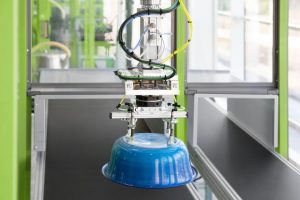
There are always new optimizations happening in the industry that ensure process quality.
According to Plastics News:
“In injection molding, the component weight reflects the process consistency and the component quality. Components are therefore often weighed manually after production or automatically placed on a scale and picked up again. ENGEL has now developed a high-precision load cell for inline weight measurement that can be integrated directly between the rotary axes and the end-of-arm tooling of a linear robot. This allows the component weight to be recorded without loss of time during on-going production, and without having to deposit the components for weighing.
“The weight of a molded part is a meaningful parameter both for repeatable manufacturing and for economic testing of components. Based on the weight, the plastics processor can quickly determine whether, for example, sprues have been cut cleanly or whether under- or over injection has occurred. Also sink marks due to missing holding pressure, which lead to a lower component weight, can be detected quickly. Insert applications are another use case. Missing inserts are detected by checking the weight immediately after the injection molding process. With the aid of weighing, NOK parts can be automatically separated from good parts. Inline weighing is therefore a 100% parts check.
Highest measuring precision
“What makes reliable and precise measuring directly on the robot arm difficult is the many external influencing factors that can impact on the measurement accuracy. These include, for example, vibrations caused by machine movements or the media guidance. As a general rule, the less the robot or transfer head moves and the slimmer the media guidance is, the more accurate the measurement will be. Taking these aspects into account, ENGEL has succeeded in developing a weighing system for the viper series linear robots in the 12 to 120 size range that achieves the highest measuring accuracy of comparable systems on the market.
“The weight measuring system is integrated directly between the rotary axes and the transfer head of the linear robot (Fig. 1) and equipped with overload protection (pin and stop edge). This protects the sensors even in the event of a significant overload. Too high a payload only reduces the measuring accuracy.
Industry 4.0 as a driver
“The increasing demand for integrated systems is a logical consequence of the use of intelligent assistance systems in industrial 4.0 strategies. To ensure quality and further process optimization, specific data are recorded, including the part weight. In many applications, weighing the components provides an additional quality check on top of the monitoring and assistance systems already integrated in the injection molding machine, such as iQ weight control from ENGEL’s ‘inject 4.0’ program.
“For integrated robots, the user interface of the weight measuring system can be found in the injection molding machine control unit (CC300), which makes weight monitoring particularly easy. In the sequence editor, there is a standard sequence for the weighing process; in addition, all recorded measured values are stored in the machine history. To be able to offer the weight measuring system for “stand-alone” robots, too, ENGEL has programmed a separate screen for the hand-held unit.
Deployed in the automotive industry
“The main drivers of development are the automotive industry and domestic appliance manufacturers. One of the early adopters of the weight measuring system is automotive supplier ZKW Lichtsysteme GmbH in Wieselburg/Austria (Fig. 2). As a first step, the load cell was mounted here on a machine that produces parts with a maximum weight of 150 g. ‘The application works very reliably with a constant weight; this is precisely why it gives us the opportunity to determine the potential of the new weight measuring system,’ explains Markus Benedikt, Process Engineering Injection Molding at ZKW. ‘Initial trial measurements have already confirmed the very excellent measuring precision.’
“Following this positive experience, the system is now being tested in a critical application with larger parts with a shot weight of 750 g. ‘We expect a significant increase in efficiency here due to locating the inspection process for the parts directly in the on-going production process,’ says Benedikt.”